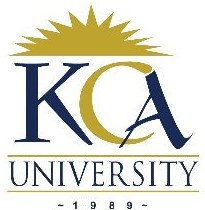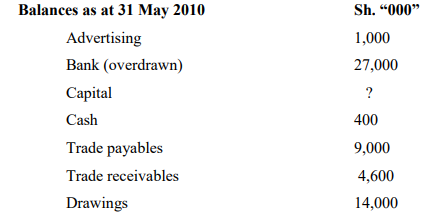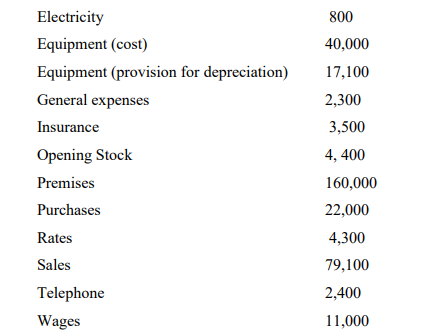
UNIVERSITY EXAMINATIONS: 2013/2014
ORDINARY EXAMINATION FOR THE BACHELOR OF SCIENCE
IN INFORMATION TECHNOLOGY
BIT 1309 FINANCIAL MANAGEMENT FOR IT
DATE: APRIL, 2014 TIME: 2 HOURS
INSTRUCTIONS: Answer Question ONE and any other TWO
QUESTION ONE
a) Describe any Six users of financial statements. Within your description, comment
on the needs of each user. (12 Marks)
b) Discuss the limitations of financial accounting (6 Marks)
c) i. Discuss main stages in the accounting cycle (4 Marks)
ii. How are the stages described above relate to input- processing- output
relationship of a system (4 Marks)
d) Differentiate between direct and indirect costs in the context of manufacturing
accounts (4 Marks)
QUESTION TWO
The following ledger balances were extracted from the books of the Rufus Hotel:


Required:
i) Prepare a Trial Balance as at 31 May 2010, disclosing the Capital balance (4 Marks)
and
ii) Statement of Financial performance for the year ended 31 May 2010 and the
Statement of Financial position as at that date, incorporating the following
adjustments: (16 Marks)
a) The closing stock at 31 May 2010 was Sh.3600,000
b) Provide for depreciation on equipment 20% per annum on a straight line basis
c) Insurance is prepaid by Sh.500,000
d) An electricity bill of Sh.200,000 is outstanding
QUESTION THREE
Assume you started a business on 1st
March 2013. Prepare the necessary accounts
balance them off and extract a trial balance from the following information.
March 1 Started firm with capital in cash of Shs.250,000.
“ 2 Bought goods on credit from the following persons: R Kamanzi
Shs.54,000; P Muiru Shs. 87,000; J Rufus Shs.25,000; D Wasilwa
Sh.76,000; Ian Matu Shs.64,000.
“4 Sold goods on credit to: C Wanje Shs.43,000; B Linda Shs.62,000 ; F
Karimi Shs.176,000.
“ 6 Paid rent by cash Shs.12,000.
“ 9 C Wanje paid us his account by cheque Shs33,000.
“ 10 F Karimi paid us Shs.150,000 by cheque.
“ 12 We paid the following by cheque: J Rufus Shs.25,000; R Kamanzi
Shs.54,000.
“ 15 Paid carriage by cash Shs.23,000.
“ 18 Bought goods on credit from P Muiru Shs.43,000; Wasilwa Kshs.110,000.
“ 21 Sold goods on credit to B Linda Shs.67,0000.
“ 31 Paid rent by cheque Shs.18,000.
QUESTION FOUR
a) Give the accounting definition of the term depreciation (2 Marks)
b) Using a suitable example in each case explain the factors that cause the assets to
depreciate (6 Marks)
c) The following information appeared in the balance sheet as Paradiso transporters
Ltd as at 31 December 2010
Motor vehicles Sh. “000”
Cost 13,500
Accumulated depreciation (5750)
NBV 7750
The following is information is relevant for the year 2011
1 Acquired a pick-up KBM at a cost of 15,000,000
2 Disposed off a bus KBA at 750,000. This bus was acquired in the year 2008 at cost
of 3m.
3 Traded in an old truck for a new one making an additional cash payment of 1.2m.
The old truck was acquired in 2008 at a cost 2.4 m and for trading purposes was
valued at 900,000.
4 As per the company’s policy motor-vehicles are depreciated at 15% straight line
basis full depreciation is given in the years of acquisition non in the year of disposal
Required
Prepare:
i. Motor-vehicle account (4 Marks)
ii. Provision for depreciation account (4 Marks)
iii. Motor-vehicle disposal account (4 Marks)
QUESTION FIVE
a) Discuss the significant differences between receipts and payments account and
income and expenditure account (8 Marks)
b) The Sellassie Hotel has been trading for a number of years. In November 2007, in
anticipation of a debt problem, a provision for doubtful debts of Sh.400,000 was
created. In subsequent years a provision of 4% of outstanding debtors is to be
made at the end of each year.
The following data applies:

Bad debts discovered within the above debtors 500 600 1,200
Required:
Calculate the provision for doubtful debts, (use net debtors) and
i. Show the income statement entries relating to bad and doubtful debts for the
years ended 30 November 2008, 2009 and 2010 (6 Marks)
ii. State the value of debtors to be shown in the statement of Financial position as at
30 November each year (6 Marks)